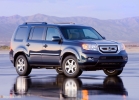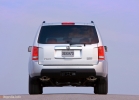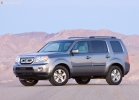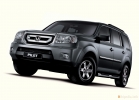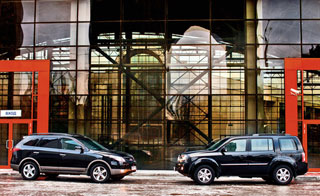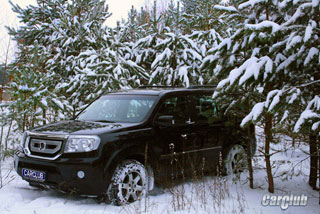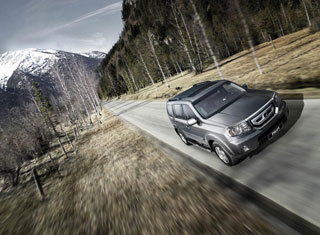Honda Pilot test drive since 2009 SUV
Test drive Honda Pilot
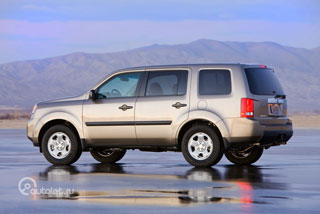 In January, when the Honda Pilot 2009 model year in the form of a concept first appeared at the Detroit car dealership, many observers were clearly discouraged. Unlike many crossovers currently produced, among which GM Lambda is a bright sample, Honda decided to give the second generation of Pilot a clearly utilitarian appearance.
In January, when the Honda Pilot 2009 model year in the form of a concept first appeared at the Detroit car dealership, many observers were clearly discouraged. Unlike many crossovers currently produced, among which GM Lambda is a bright sample, Honda decided to give the second generation of Pilot a clearly utilitarian appearance. As the officials of the Honda company explained during our preparation for the first testing of the Pilot 2009, they wanted to maintain the practicality of the SUV by placing the main emphasis on the maximum useful use of the internal space of the Pilot in relatively small external sizes. This means that a square body can freely accommodate (at least, as can be seen in the number of seats) eight people.
And although Pilot does not expect to compete with Buick Enclave or Mazda CX-9, he does not cut his eyes in any case. Rather, it simply does not stand out. The body resembles the greenhouse shape of the first generation of Jeep Liberty, but a little longer. Contrary to its barn appearance, the body has the best aerodynamic properties than the original Pilot, which makes it less noisy in motion. However, there are several more positions that can be regarded as a step back.
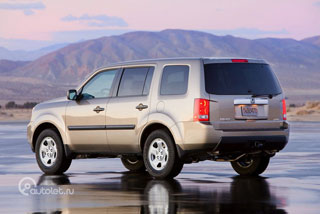 About everything in order. If you do not pay attention to the appearance of Pilot, the new car, in general, is much better than the 2008 model. Under the hood, the same in volume of the 3.5-liter V6 engine, but with a number of innovations. The new engine develops a power of 250 hp. And creates a torque by force of 253 feet-pound, increasing the previous indicators, respectively by 6 hp, and 13 feet.
About everything in order. If you do not pay attention to the appearance of Pilot, the new car, in general, is much better than the 2008 model. Under the hood, the same in volume of the 3.5-liter V6 engine, but with a number of innovations. The new engine develops a power of 250 hp. And creates a torque by force of 253 feet-pound, increasing the previous indicators, respectively by 6 hp, and 13 feet. The economy of fuel is 1 mile per gram in a complex movement mode due to the use of a deactivation system in the new version of the cylinder control system (VCM). Earlier, the VCM system simply turned off one cylinder block. In the new version, the car can operate on three, four and six cylinders, and in the mode of operation on four cylinders, the system turns off one cylinder from each unit.
The most significant changes affected the body, while high -strength steel details increased from 13 to 52 percent of the body design, which significantly increased the strength of the body. When creating the body, Honda also used advanced design design developments (ACE). According to Honda, ACE provides better passenger protection in the event of a collision with machines having an excellent bumper height. The increased width of the new model also means that Honda can use additional fastening points to accommodate three children's seats in the middle row. The fourth children's seat can be installed in the third row. The second row of seats consists of 60/40, and each side can be independently moved forward, providing additional legs for the legs sitting in the rear quarter of the car.
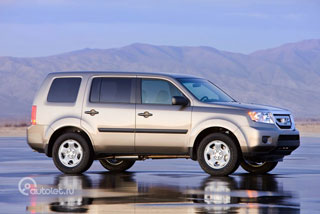 If we talk about the rear seat, then the width from the wall to the wall at the hip level is only 48.4 inches. If you move the middle seats forward, enough free space appears for the legs sitting behind, but in the case of using all three seats, passengers should be either very narrow, or they will have to endure inconvenience.
If we talk about the rear seat, then the width from the wall to the wall at the hip level is only 48.4 inches. If you move the middle seats forward, enough free space appears for the legs sitting behind, but in the case of using all three seats, passengers should be either very narrow, or they will have to endure inconvenience. The seats are located high above the floor, so the knees of the passengers will not look up, as it happens on a larger Chevy Tahoe SUV. However, if you recall once again about the width of 48.4 inches, you will understand that the places here are a little more than for four legs. This means that if you add the second and third row of seats, you can install a pan 4 x 4 feet.
As usual, the seats are magnificent, and here Honda shines. As well as in the ACCORD car, the seats on the Pilot are surprisingly convenient and elastic. The instrument panel has acquired a new and interesting appearance. The devices have transparent front panels, and the arrows resemble ancient radio indicators. The selection selector moved from the central column to the front panel, lower and to the left of the audio system.
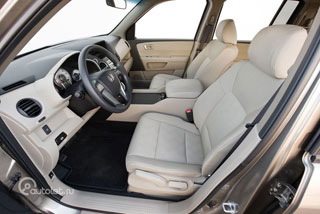 How Pilot does not differ for the better is the finish and assembly of the panel of the device. The plastic parts are very hard, and the finish looks cheaper than on Honda Fit. Probably the most unsuccessful is the location and adjustment of the compounds. Compared to the existing version, the new model looks clearly cheap.
How Pilot does not differ for the better is the finish and assembly of the panel of the device. The plastic parts are very hard, and the finish looks cheaper than on Honda Fit. Probably the most unsuccessful is the location and adjustment of the compounds. Compared to the existing version, the new model looks clearly cheap. Fortunately, this is really only one detail that looks simpler. The running characteristics are improved significantly, starting from the noise of the engine. The new Pilot has an active engine mount, as well as the active suppression of the noise. In combination with an improved body design, the internal atmosphere of the Pilot car tunes in calm, both in the base model and in the new Touring model. Another advantage of a rigid design is the possibility of suspension to work more efficiently.
Pilot is very supple, easily absorbs the irregularities of the road surface, maintaining control accuracy. During maneuvering, 4,500 foot Pilot seems easier and more responsive than the GM Lambda crossovers. This is due to the fact that, contrary to increased sizes and additional equipment, previously mentioned steel structures made it possible to reduce body weight and balance it better than in previous models.
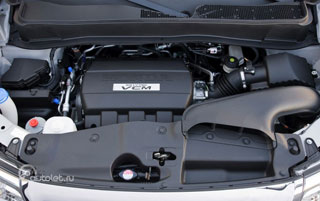 Acceleration is felt adequate for this type of car, although it will not be confused with more sports crossovers, such as the Audi Q7 TDI 4.2. On the other hand, Pilot is made with a bias in practicality, and those who seek the best running qualities can pay attention to Acura MDX, which divides the platform with the Pilot car. Again, even a family universal car should be able to instantly stop, and new 13-inch wheels with disk front and rear brakes, according to the manufacturer, reduce the distance when braking is 11 percent. The Pilot stability management also exceeds other Honda cars we tested.
Acceleration is felt adequate for this type of car, although it will not be confused with more sports crossovers, such as the Audi Q7 TDI 4.2. On the other hand, Pilot is made with a bias in practicality, and those who seek the best running qualities can pay attention to Acura MDX, which divides the platform with the Pilot car. Again, even a family universal car should be able to instantly stop, and new 13-inch wheels with disk front and rear brakes, according to the manufacturer, reduce the distance when braking is 11 percent. The Pilot stability management also exceeds other Honda cars we tested. The execution of maneuvers on a narrow road with gravel coating is confirmed by the results of official tests showing that stability management is performed extremely softly and efficiently. We noticed the only dynamic problem in the presence of some twisting moment on the front -wheel drive model Pilot.
The test route did not allow us to try out a new auxiliary system when touched on the slope, so we will have to wait for another test drive. The system of assistance when touched on the slope uses an accelerometer of longitudinal accelerations to determine the location of the car on the slope. If you press the brake, stopping the Pilot on the slope, and then release the brake, the anti -circus system holds the pressure in the brakes until you press the gas. Brakes are released along with the opening of throttle.
In general, Honda Pilot 2009 is unlikely to make the heart bewitted. The car was created for work, that is, to ensure comparative convenience to a bunch of people or a small team. What this car can be useful is its abilities. It is softer, quieter and clearly more economical than its predecessor, and when compared with the Touring decoration, or more expensive relative Acura, the new Pilot looks just a tramp. However, if Honda once again looks at the finish of the dashboard and the exterior finish of the car, we will be more favorable.
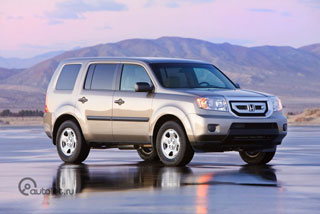
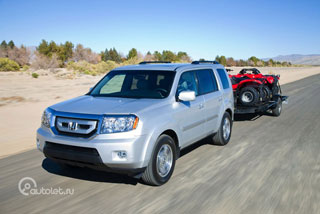
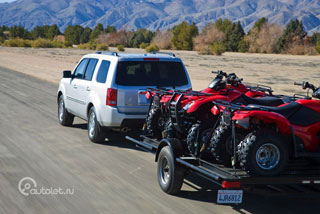
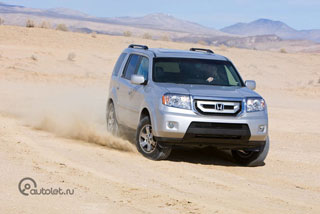
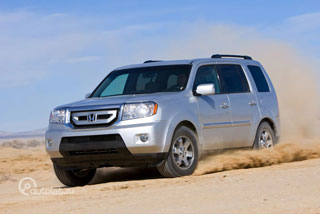
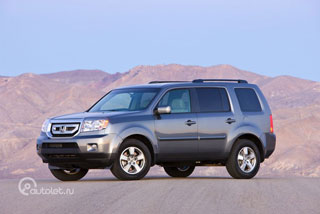
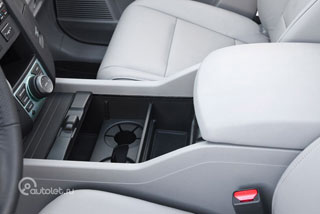
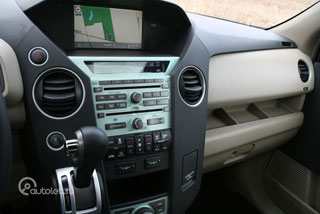
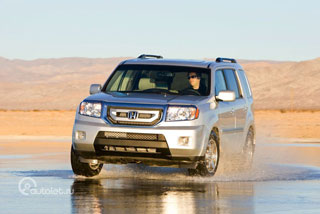
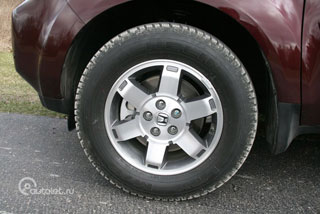
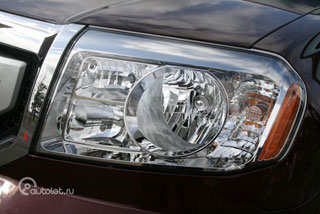
Source: autolet.ru

